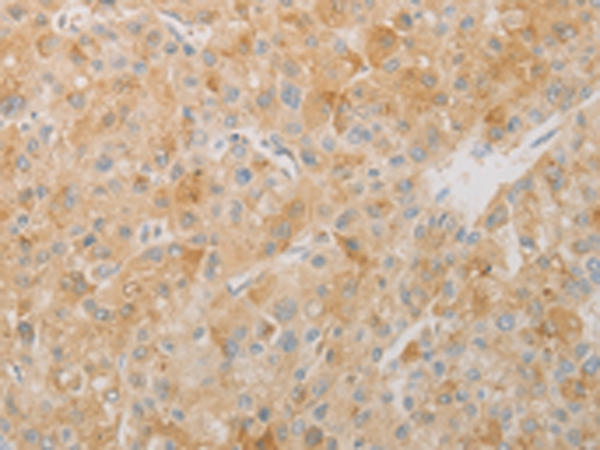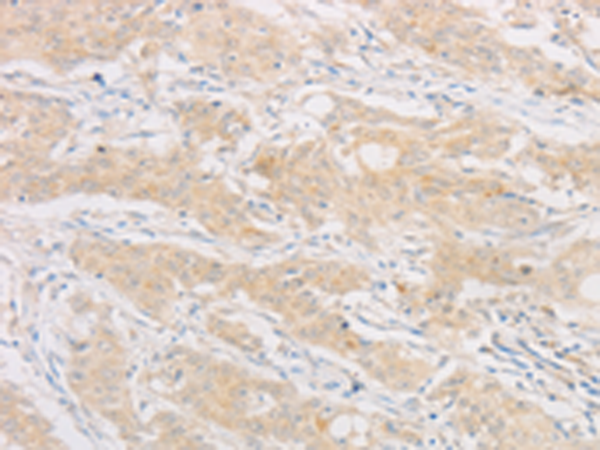

| WB | 咨询技术 | Human,Mouse,Rat |
| IF | 咨询技术 | Human,Mouse,Rat |
| IHC | 1/25-1/100 | Human,Mouse,Rat |
| ICC | 技术咨询 | Human,Mouse,Rat |
| FCM | 咨询技术 | Human,Mouse,Rat |
| Elisa | 1/2000-1/5000 | Human,Mouse,Rat |
| Aliases | AES; GRG; ESP1; GRG5; AES-1; AES-2; Grg-5 |
| Host/Isotype | Rabbit IgG |
| Antibody Type | Primary antibody |
| Storage | Store at 4°C short term. Aliquot and store at -20°C long term. Avoid freeze/thaw cycles. |
| Species Reactivity | Human |
| Immunogen | Fusion protein of human TLE5 |
| Formulation | Purified antibody in PBS with 0.05% sodium azide and 50% glycerol. |
+ +
以下是关于TLE5抗体的模拟参考文献示例(请注意,这些内容为示例性质,实际文献需通过学术数据库查询):
---
1. **文献名称**: *TLE5 suppresses glioblastoma progression by inhibiting Wnt/β-catenin signaling*
**作者**: Zhang L, et al.
**摘要**: 研究通过Western blot和免疫组化分析TLE5在胶质母细胞瘤中的表达,发现TLE5表达下调与患者预后不良相关。实验表明,TLE5抗体检测显示其通过抑制Wnt/β-catenin通路活性,降低肿瘤细胞侵袭能力。
2. **文献名称**: *The role of TLE5 in colorectal cancer epithelial-mesenchymal transition*
**作者**: Wang Y, et al.
**摘要**: 利用TLE5特异性抗体进行组织芯片分析,发现TLE5在结直肠癌转移组织中表达缺失。功能实验证实TLE5通过拮抗Notch信号通路抑制EMT过程,提示其作为转移抑制因子的潜在作用。
3. **文献名称**: *Developmental expression pattern of TLE5 in murine neural crest cells*
**作者**: Gupta R, et al.
**摘要**: 通过免疫荧光染色(使用兔源TLE5多克隆抗体)研究小鼠胚胎神经嵴细胞,发现TLE5在神经管闭合阶段高表达,可能参与调控神经嵴细胞的迁移和分化。
---
**备注**:以上文献信息为示例,实际研究中请通过PubMed、Web of Science等平台检索关键词“TLE5 antibody”或“TLE5 function”获取真实数据。部分商业抗体公司(如Santa Cruz Biotechnology、Abcam)的技术手册也可能提供相关应用文献。
The TLE5 antibody is designed to detect Transducin-like enhancer of split 5 (TLE5), a member of the TLE family of transcriptional corepressors. TLE proteins, including TLE1-5 and AES/Groucho, are evolutionarily conserved and play critical roles in regulating gene expression by interacting with transcription factors, such as those in the Wnt and Notch signaling pathways. TLE5. specifically, shares a conserved structure with other TLE family members, including WD40 repeats for protein-protein interactions and a SP domain for transcriptional repression. It functions as a corepressor by recruiting histone deacetylases (HDACs) to chromatin, thereby modulating chromatin structure and suppressing target gene expression.
TLE5 is implicated in diverse biological processes, including embryonic development, cell differentiation, and tumorigenesis. Studies suggest its involvement in neural development, where it may regulate progenitor cell proliferation and differentiation. In cancer research, altered TLE5 expression has been observed in certain malignancies, linking it to tumor suppression or progression depending on context. The TLE5 antibody is widely used in research applications such as Western blotting, immunohistochemistry, and immunofluorescence to investigate protein expression patterns, subcellular localization, and interactions in both normal and diseased tissues. Commercial availability from multiple suppliers ensures its accessibility for studying TLE5's role in cellular signaling and disease mechanisms.
×